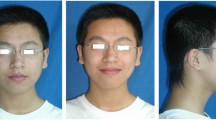Abstract
BACKGROUND: Primary failure of tooth eruption (PFE) is a rare condition affecting any or all posterior quadrants. Unilateral involvement of maxillary and mandibular quadrants causes a dramatic posterior open bite that requires complex management strategies. CASE REPORT: An 8 year-old boy attended the Dublin Dental School and Hospital regarding infra-occlusion of his right maxillary and mandibular primary molars. Both right first permanent molars had also failed to erupt. All permanent teeth were present radiographically. Facial appearance and soft tissues were normal and oral function was not affected. The patient had no significant medical history and his siblings had no similar dental abnormalities. TREATMENT: The infra-occluded right first and second primary molars were extracted, and the right first permanent molars were surgically exposed. FOLLOW UP: Eruption of the premolars and molars was monitored over the next 2 years. The premolars showed signs of eruption and continued root development. Exfoliation of the remaining primary teeth proceeded as usual. The right first permanent molars did not erupt and were subsequently extracted. Continued eruption of the canines and premolars reduced the inter-arch separation. A removable tongue shield appliance was suggested but declined by the patient. At age 13 years, orthodontic extrusion was used to further reduce the inter-dental distance between the canine and premolars. The reduction was from 5 mm to 1.5 mm between the right first premolars and from 10 mm to 5 mm between the right second premolars. Extrusion of the canine teeth was also attempted to improve the smile line. The canine extruded 1mm to give a 2mm overlap. There were no changes in centric occlusion and the midline was unaffected. In the 2 years since orthodontic treatment, the spaces have reopened slightly to 3 mm between first premolars and 6 mm between second premolars. The patient is now aged 16 years and is aware that an improved aesthetic smile line may be achieved by use of onlay restorations. CONCLUSION: In this unique case, a profound unilateral posterior open bite occurred due to primary failure of eruption of the maxillary and mandibular teeth on the affected side. Orthodontic therapy was used to modify the position of the permanent canines and premolars to reduce the posterior open bite.
Similar content being viewed by others
References
Bierderman, W, Chem B. Etiology and treatment of tooth ankylosis. Am J Orthod Dentofacial Orthop, 1962;48:670–84.
Bjerklin K, Kurol J, Valentin J. Ectopic eruption of maxillary first permanent molars and association with other tooth and developmental disturbances. Eur J Orthod, 1992;14:369–75.
Brady J. Familial primary failure of eruption of permanent teeth. Brit J Orthod, 1990;17:109–13.
Cahill D. Eruption pathway formation in the presence of experimental tooth impaction in puppies. Anat Rec, 1969;164:67–77.
Dibias A, Leggat TG. Primary failure of eruption in the permanent dentition of siblings. Int J Paediatr Dent, 2000;10:153–7.
Frazier-Bowers SA, Simmons D, Wright JT, Proffit WR, Ackerman JL. Primary failure of eruption and pth1r: the importance of a genetic diagnosis for orthodontic treatment planning. Am J Orthod Dentofacial Orthop. 2010;37:160.
Frazier-Bowers SA, Koehler KE, Ackerman JL, Proffit WR. Primary failure of eruption: further characterization of a rare eruption disorder. Am J Orthod Dentofacial Orthop, 2007;131:578–e1–11.
Ireland AJ. Familial posterior open bite: a primary failure of eruption. Brit J Orthod, 1991;18:233–7.
Kuro J. Thilander B. Infraocclusion of primary molars and the effect on occlusal development, a longitudinal study. Eur J Orthod, 1984:6:277–93.
O’connell AC, Torske KR. Primary failure of tooth eruption: a unique case. Oral Surg Oral Med Oral Pathol Oral Radiol Endod, 1999;87:714–20.
Proffit WR, Vig KW. Primary failure of eruption: a possible cause of posterior open-bite. Am J Orthod, 1981;80:173–90.
Raghoebar GM, Boering G, Jansen HW, Vissink A. Secondary retention of permanent molars: a histologic study. J Oral Pathol Med, 1989;18:427–31.
Stellzig-Eisenhauer A, Decker E, Meyer-Marcotty P, et al. Primary failure of eruption (pfe) clinical and molecular genetics analysis. J Orofac Orthop, 2010;71:6–16.
Winter GB, Gelbier MJ. Goodman JR. Severe infra-occlusion and failed eruption of deciduous molars associated with eruptive and developmental disturbances in the permanent dentition: a report of 28 selected cases. Brit J Orthod, 1997;24:149–57.
Author information
Authors and Affiliations
Corresponding author
Rights and permissions
About this article
Cite this article
Cafferty, J.M., Awadi, E.A. & O’Connell, A.C. Management of severe posterior open bite due to primary failure of eruption. Eur Arch Paediatr Dent 11, 158 (2010). https://doi.org/10.1007/BF03262734
Published:
Issue Date:
DOI: https://doi.org/10.1007/BF03262734




